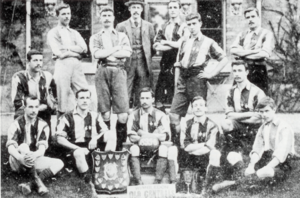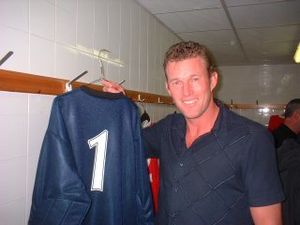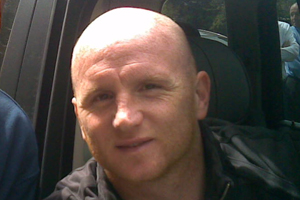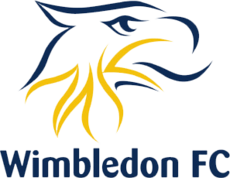Wimbledon F.C. facts for kids
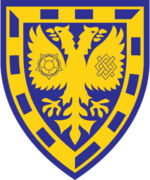
Badge used 1981–2003; see below for others
|
|||
| Full name | Wimbledon Football Club | ||
|---|---|---|---|
| Nickname(s) | The Dons, The Wombles, The Crazy Gang | ||
| Founded | 1889 (as Wimbledon Old Centrals) | ||
| Dissolved | 21 June 2004 (Relocation of Wimbledon F.C. to Milton Keynes) | ||
| Ground |
|
||
|
24th (Relegated from First Division) |
||
|
|
|||
Wimbledon Football Club was a famous English football team from Wimbledon, south-west London. It was started in 1889 and played at Plough Lane for many years. For most of its history, the club was a "non-League" team, meaning it played outside the main professional football leagues.
The team was known as "the Dons" and later also "the Wombles". They won many titles in amateur leagues, including the FA Amateur Cup in 1963. From 1975 to 1977, they won the Southern Football League three times in a row. This success helped them get chosen to join the Football League in 1977.
Wimbledon quickly became very successful in the 1980s. They moved up from the Fourth Division to the top league, the First Division, in just four seasons by 1986. The team was nicknamed "The Crazy Gang" because their players were known for being wild and fun. In 1988, they achieved their biggest win by beating the strong team Liverpool to win the FA Cup.
In 1991, Wimbledon had to leave Plough Lane. This was because new rules required top-flight clubs to have stadiums where everyone could sit. They shared a stadium with Crystal Palace at Selhurst Park for over ten years. The team stayed in the top league until they were moved down in 2000.
In 2001, the club decided to move about 56 miles (90 km) north to Milton Keynes. Many fans and football supporters were very unhappy about this. However, an independent group allowed the move in May 2002. Because of this, a group of fans started a new club called AFC Wimbledon. Many original Wimbledon fans chose to support this new team instead.
Contents
The Story of Wimbledon FC
Early Days and Amateur Success
Wimbledon Old Central Football Club started in 1889. Its name came from the Old Central School near Wimbledon Common, where the players went to school. Their first game was a 1–0 win against Westminster. They quickly found success, winning two leagues in 1895–96.
In 1905, the club changed its name to Wimbledon Football Club. They won the South London Charity Cup that year. However, the club faced money problems and closed down in 1910. It restarted a year later as Wimbledon Borough, but "Borough" was soon dropped. In 1912, the team found a permanent home at Plough Lane.
Wimbledon joined the Isthmian League in 1919. They became very strong in the 1930s, winning four Isthmian League titles. They also reached the final of the FA Amateur Cup in 1935. After World War II, they reached another FA Amateur Cup final in 1947.
The club had a period of great success in the late 1950s and early 1960s. They won the Isthmian League five times, including three years in a row from 1962 to 1964. In 1963, Wimbledon won the FA Amateur Cup, beating Sutton United 4–2. Their top goalscorer, Eddie Reynolds, scored all four goals with his head. This was a unique achievement at Wembley.
Becoming Professional and Joining the Football League
After these wins, Wimbledon decided to become a professional club in 1964. They joined the Southern Football League. In 1975, Wimbledon became famous during an FA Cup run. They were a non-League team but beat a top-division team, Burnley, away from home. In the next round, they drew 0–0 with the champions, Leeds United. Their goalkeeper, Dickie Guy, saved a penalty. They lost the replay 1–0 in front of over 40,000 fans.
Wimbledon then won the Southern League three times in a row from 1975 to 1977. This success led to them being chosen to join The Football League for the 1977–78 season.
Climbing the Football League Ranks
Wimbledon had a good first season in the Football League Fourth Division, finishing 13th. They were promoted to the Third Division in 1979. However, they struggled and were moved back down the next season.
In 1980, Dave Bassett became the manager. Under him, Wimbledon quickly climbed the leagues. They were promoted back to the Third Division in 1981. In 1983, they won the Fourth Division championship. The next season, 1983–84, they were promoted again to the Second Division.
The 1984–85 season was their first in the Second Division. They finished a strong 12th place. The following year, they continued to impress. In 1986, Wimbledon earned promotion to the top league, the First Division. This was an amazing achievement, as they had gone from the Fourth Division to the First Division in just four years!
Life in the Top League
Many people thought Wimbledon would quickly be moved back down in 1986–87. But they surprised everyone by starting the season very well and finishing sixth. Dave Bassett then left, and Bobby Gould became the new manager.
The team was known as "The Crazy Gang" because of their players' lively and unpredictable behaviour. Their most famous moment came in 1988 when they won the FA Cup. They beat the strong favourites, Liverpool, 1–0 with a goal from Lawrie Sanchez. Their goalkeeper and captain, Dave Beasant, made history by saving a penalty in the final. This was a huge upset!
After the FA Cup win, Wimbledon continued to do well in the First Division. They finished 12th in 1989 and eighth in 1990. In 1990, Ray Harford took over as manager. The team finished seventh in 1991.
Moving from Plough Lane
At the end of the 1990–91 season, Wimbledon had to leave Plough Lane. New rules from the FA said that all top-league stadiums needed to have seats for everyone. The club decided that Plough Lane could not be easily changed to meet these rules. So, they moved to Selhurst Park in 1991, sharing the stadium with Crystal Palace.
In 1992, Joe Kinnear became the manager. He guided Wimbledon to a 13th-place finish in the First Division. This meant they would be part of the new FA Premier League when it started.
Wimbledon continued to be a tough team in the Premier League. In 1993–94, they had one of their best seasons, finishing sixth. They also reached the quarter-finals of the League Cup. In 1995, they played in a European competition called the Intertoto Cup. However, they used a weaker team and were banned from European competitions the next season.
In 1996–97, Wimbledon started very well. They reached the semi-finals of both the FA Cup and the League Cup. They finished eighth in the league.
The Final Years and Relocation
In 1997–98, Wimbledon started strong but finished 15th. The next season, 1998–99, was similar. They signed John Hartson for a club record fee. They reached the League Cup semi-finals but finished 16th in the league.
In 1999, Joe Kinnear left due to health reasons. Egil Olsen became the new manager. The team's league form got worse. Olsen left in May 2000. On May 14, 2000, exactly 12 years after their FA Cup win, Wimbledon were moved down from the top league after 14 years. This happened after they lost to Southampton and Bradford City won their game.
Terry Burton then managed the team for two seasons in the second division. They just missed out on promotion play-offs twice.
The Move to Milton Keynes
In August 2001, the club announced it wanted to move to Milton Keynes. Many Wimbledon fans, the Football League, and the Football Association were against this. But on May 28, 2002, an independent group allowed the move.
This decision made many fans very upset. They decided to start a brand new club called AFC Wimbledon. Many original Wimbledon fans switched to support this new team. The new club had more fans at its games than the original Wimbledon team did in its final years in London.
Stuart Murdoch became the manager. In June 2003, the club faced financial difficulties. They played their first game in Milton Keynes in September 2003. Even though more people came to games in Milton Keynes, the club was in trouble. They sold many players, and the team finished at the bottom of the league.
At the end of the 2003–04 season, the club's financial problems were sorted out. They were then officially renamed "Milton Keynes Dons".
Club Identity
|
|
| The kit worn in the 1988 FA Cup Final |
Wimbledon's main nickname was "the Dons." People also often called them "the Wombles" from the mid-1970s. After winning the FA Cup in 1988, the team was also known as "The Crazy Gang" because of their players' fun and wild behaviour.
In 2000, the club introduced a Womble mascot named "Wandle," after the local River Wandle. However, after the club moved in 2003, the Wombles' owners did not allow the club to use the mascot anymore. Later, a similar Womble mascot named Haydon appeared at AFC Wimbledon.
The club's main colours were blue and yellow. In their early days, they wore different combinations of blue, white, green, and black. By 1918, they settled on royal blue shirts with navy blue shorts and socks. In the 1950s, the shorts changed to white. From 1975, they started using blue and yellow. In 1981, they adopted an all-blue kit with yellow details. This kit stayed mostly the same until 1993, when a darker navy blue was used. This darker blue was their colour for the rest of their history. For away games, they often wore red or green kits.
The first badge on their shirts was the emblem of the Municipal Borough of Wimbledon. This was used until the mid-1950s. The emblem returned in the early 1970s. When they joined the Football League in 1977, they got their own badge. This badge was similar to the one most people remember, but it had white instead of yellow. Yellow replaced white in 1981, and this logo was used until 2003.
After the club's move to Milton Keynes was approved, they were told they could not use the old borough emblem anymore. A new logo was approved in 2003. It showed a stylised eagle's head from the Wimbledon arms, drawn in navy blue and yellow. The yellow part also looked like the letters "MK" for Milton Keynes. However, this new logo was not always used on their kits or official papers.
Stadium History
Wimbledon first played on Wimbledon Common. Their clubhouse was a pub called the Fox and Grapes. In September 1912, they moved to Plough Lane. In the 1930s and 1940s, between 7,000 and 10,000 fans would often come to games. The biggest crowd at Plough Lane was 18,080 people in 1935 for an FA Amateur Cup game.
Plough Lane remained a simple stadium. Even when Wimbledon reached the top division, it hadn't changed much from their amateur days. After the Hillsborough disaster, new safety rules were made. Top clubs had to make their stadiums all-seater. Wimbledon's board decided that it was too expensive to update Plough Lane. So, in 1990, they announced they would temporarily share Selhurst Park with Crystal Palace.
The club looked for a new stadium site in or around Merton for five years. They also considered redeveloping Plough Lane. However, none of these plans worked out. Wimbledon ended up staying at Selhurst Park for twelve years.
Wimbledon's first game in Milton Keynes was on September 27, 2003, at the National Hockey Stadium. The club played there for its final season. This stadium then became the first home of Milton Keynes Dons.
| Period | Stadium | Borough/Town |
|---|---|---|
| 1889–1912 | Wimbledon Common | Merton |
| 1912–1991 | Plough Lane | Merton |
| 1991–2003 | Selhurst Park | Croydon |
| 2003–2004 | National Hockey Stadium | Milton Keynes |
Fan Support
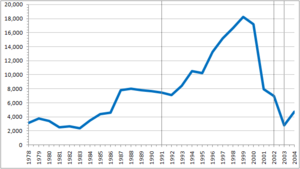
First vertical line (from left) – move to Selhurst Park (1991)
Second – confirmation of move to Milton Keynes (2002)
Third – Move to Milton Keynes (2003)
Because Plough Lane was small and Wimbledon rose so quickly, they had fewer fans than other top teams. In their first Football League season in 1977, they averaged about 3,135 fans. By 1986, when they reached the top league, this had grown to 7,811.
After moving to Selhurst Park in 1991, attendances slowly grew. They reached a peak of 18,235 in 1998–99. In their last Premier League season, 1999–2000, they averaged 17,157 fans.
When the club was moved down from the Premier League, and with the planned move to Milton Keynes, fan numbers dropped. In 2000–01, they averaged only 7,897 fans, as many fans boycotted games to protest the move. In the 2001–02 season, before the move was confirmed, they averaged 6,961 fans.
After the move was allowed, most fans left to support AFC Wimbledon, the new club started by supporters. In 2002–03, AFC Wimbledon's first season, their average crowds were actually higher than the original club's. In Wimbledon's final season (2003–04) in Milton Keynes, they averaged 4,751 fans, while AFC Wimbledon averaged 2,606.
There were two main fan groups: the official Wimbledon F.C. Supporters Club and the Wimbledon Independent Supporters Association (WISA). The WISA helped organize the boycotts and later helped create The Dons Trust and AFC Wimbledon.
Team Rivals
When Wimbledon was an amateur or semi-professional team, they had a strong local rivalry with Tooting & Mitcham United F.C..
From the mid-1980s, fans saw their main rivals as fellow south London club Crystal Palace (who were their landlords at Selhurst Park) and west London team Chelsea. However, these feelings were not always as strong from the other clubs' fans. Wimbledon played in the same division as Crystal Palace for 11 seasons and as Chelsea for most seasons between 1986 and 2000.
Club Records and Statistics
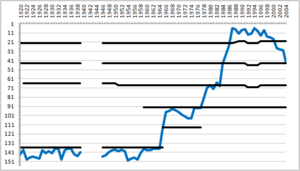
Horizontal black lines represent (from top):
1 (post-1992) – Premier League
2–4 (1–4 pre-1992) – The Football League
4–6 – Southern Football League
6 – Athenian League; Isthmian League
The player with the most appearances for Wimbledon was Roy Law, who played 644 times between 1958 and 1972. He also holds the record for most league appearances with 433 games.
Wimbledon's all-time top goalscorer was Eddie Reynolds, who scored an amazing 340 goals in 329 matches from 1957 to 1966. Ian Cooke was second with 297 goals and played 615 times.
For games in The Football League, Alan Cork holds both the appearance and goal records. He scored 145 league goals in 430 matches. Cork also scored the most league goals in one season, with 29 in 1983–84.
The most expensive player Wimbledon ever bought was John Hartson, costing £7.5 million in 1999. The highest fee they received for a player was £7 million for Carl Cort in 2000.
Wimbledon's biggest win was a 6–0 league victory over Newport County in 1983. Their worst defeat was an 8–0 League Cup loss to Everton in 1978.
The longest time Wimbledon went without losing a league game was 22 matches in 1984. Their longest winning streak in the league was seven matches, achieved twice (in 1983 and 1996). Their longest losing streak was eleven matches in a row in 2004.
Wimbledon's highest attendance at Selhurst Park was 30,115 for a Premier League match against Manchester United in 1993. However, their official home record at their true home, Plough Lane, was 18,080 against HMS Victory in 1935.
European Games
Wimbledon only played in one European competition, the Intertoto Cup, in 1995.
| Season | Competition | Round | Club | Home | Away |
|---|---|---|---|---|---|
| 1995 | Intertoto Cup | Group Stage | 0–41 | ||
| 1–1 | |||||
| 0–01 | |||||
| 0–3 |
1Both home matches in this competition were played at Brighton and Hove Albion's Goldstone Ground, as Selhurst Park was unavailable.
Players
Final Team Squad
This list shows the players who were part of the Wimbledon F.C. team for their very last league match on May 9, 2004.
|
|
- a These players stayed to play for Milton Keynes Dons.
- b These players later played for AFC Wimbledon.
Famous Former Players
Managers

Before 1930, a committee chose the team. Then, Doc Dowden became manager in 1946 and stayed until 1955. Les Henley took over in 1955 and managed for 16 years. During his time, the club grew a lot, winning the FA Amateur Cup and three Isthmian League championships. He was manager when the club became professional.
After Henley, several managers had shorter spells, including Mike Everitt and Dick Graham. In 1974, Allen Batsford became manager. He led Wimbledon into The Football League.
Dario Gradi then took over in 1978. After him, Dave Bassett became manager in 1981. Bassett was the manager who guided Wimbledon all the way to the top division. He left in 1987.
Bobby Gould managed the team for three years, including their famous FA Cup win in 1988. Ray Harford and Peter Withe then had short periods as manager.
In 1992, Joe Kinnear became manager. He led the club into the new FA Premier League and managed them until 1999. After Kinnear, Egil Olsen was manager for a season, during which the team was moved down from the Premier League. Terry Burton then managed for two seasons.
Finally, Stuart Murdoch managed Wimbledon for the club's last two seasons before it was renamed.
| Name | Nationality | From | To | Matches | Won | Drawn | Lost | Win % | Notes |
|---|---|---|---|---|---|---|---|---|---|
| H.R. Watts | 1930 | 1946 | |||||||
| Doc Dowden | 1946 | August 1955 | 375 | 186 | 64 | 126 | 49.6 | ||
| Les Henley | August 1955 | 5 April 1971 | 869 | 468 | 156 | 235 | 53.9 | ||
| Mike Everitt | 5 April 1971 | 6 August 1973 | 120 | 49 | 26 | 45 | 40.8 | ||
| Dick Graham | 18 August 1973 | 16 March 1974 | 45 | 16 | 14 | 15 | 35.6 | ||
| Allen Batsford | July 1974 | 2 January 1978 | 231 | 131 | 51 | 49 | 56.7 | ||
| Dario Gradi | 5 January 1978 | 24 January 1981 | 171 | 63 | 47 | 61 | 36.8 | ||
| Dave Bassett | 31 January 1981 | 17 June 1987 | 303 | 144
align=center|74 |
85 | 47.5 | |||
| Bobby Gould | 26 June 1987 | 18 June 1990 | 142 | 57 | 43 | 42 | 40.1 | ||
| Ray Harford | 18 June 1990 | 7 October 1991 | 56 | 20 | 17 | 19 | 35.7 | ||
| Peter Withe | 7 October 1991 | 19 January 1992 | 17 | 1 | 9 | 6 | 5.9 | ||
| Joe Kinnear | 19 January 1992 | 9 June 1999 | 364 | 130 | 109 | 125 | 35.7 | ||
| Egil Olsen | 9 June 1999 | 1 May 2000 | 43 | 11 | 12 | 20 | 25.6 | ||
| Terry Burton | 1 May 2000 | 25 April 2002 | 108 | 39 | 39 | 30 | 36.1 | ||
| Stuart Murdoch | 25 June 2002 | 7 August 2004 | 101 | 30 | 17 | 54 | 29.7 |
Club Achievements
Wimbledon was a very successful club, even before joining The Football League. They won eight Isthmian League titles, including three in a row from 1962 to 1964. They also won the Southern Football League three times in a row from 1975 to 1977.
After joining the Football League, Wimbledon continued to win. Their most famous win was the FA Cup in 1988. This made them one of only three clubs to win both the FA Cup and its amateur version. Despite their quick rise, they only won one league championship within the Football League: the Football League Fourth Division title in 1982–83.
| Honour | Year(s) | |
|---|---|---|
| FA Cup | Winners | 1987–88 |
| Football League Second Division | Promotion | 1985–86 |
| Football League Third Division | Promotion | 1983–84 |
| Football League Fourth Division | Champions | 1982–83 |
| Promotion | 1978–79, 1980–81 | |
| FA Amateur Cup | Winners | 1962–63 |
| Runners-up | 1934–35, 1946–47 | |
| Football League Group Trophy | Runners-up | 1980–81 |
| Anglo-Italian Cup | Runners-up | 1975–76 |
| Southern Football League | Champions | 1974–75, 1975–76, 1976–77 |
| Runners-up | 1967–68 | |
| Isthmian League | Champions | 1930–31, 1931–32, 1934–35, 1935–36, 1958–59, 1961–62, 1962–63, 1963–64 |
| Runners-up | 1949–50, 1951–52 | |
| Athenian League | Runners-up | 1920–21 |
See also
 In Spanish: Wimbledon Football Club para niños
In Spanish: Wimbledon Football Club para niños


